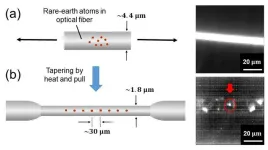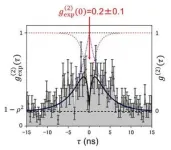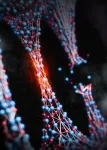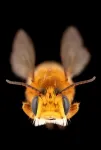(Press-News.org)
Quantum-based systems promise faster computing and stronger encryption for computation and communication systems. These systems can be built on fiber networks involving interconnected nodes which consist of qubits and single-photon generators that create entangled photon pairs.
In this regard, rare-earth (RE) atoms and ions in solid-state materials are highly promising as single-photon generators. These materials are compatible with fiber networks and emit photons across a broad range of wavelengths. Due to their wide spectral range, optical fibers doped with these RE elements could find use in various applications, such as free-space telecommunication, fiber-based telecommunications, quantum random number generation, and high-resolution image analysis. However, so far, single-photon light sources have been developed using RE-doped crystalline materials at cryogenic temperatures, which limits the practical applications of quantum networks based on them.
In a study published in Volume 20, Issue 4 of the journal Physical Review Applied on 16 October 2023, a team of researchers from Japan, led by Associate Professor Kaoru Sanaka from Tokyo University of Science (TUS) has successfully developed a single-photon light source consisting of doped ytterbium ions (Yb3+) in an amorphous silica optical fiber at room temperature. Associate Professor Mark Sadgrove and Mr. Kaito Shimizu from TUS and Professor Kae Nemoto from the Okinawa Institute of Science and Technology Graduate University were also a part of this study. This newly developed single-photon light source eliminates the need for expensive cooling systems and has the potential to make quantum networks more cost-effective and accessible.
"Single-photon light sources are devices that control the statistical properties of photons, which represent the smallest energy units of light," explains Dr. Sanaka. "In this study, we have developed a single-photon light source using an optical fiber material doped with optically active RE elements. Our experiments also reveal that such a source can be generated directly from an optical fiber at room temperature."
Ytterbium is an RE element with favorable optical and electronic properties, making it a suitable candidate for doping the fiber. It has a simple energy-level structure, and ytterbium ion in its excited state has a long fluorescence lifetime of around one millisecond.
To fabricate the ytterbium-doped optical fiber, the researchers tapered a commercially available ytterbium-doped fiber using a heat-and-pull technique, where a section of the fiber is heated and then pulled with tension to gradually reduce its diameter.
Within the tapered fiber, individual RE atoms emit photons when excited with a laser. The separation between these RE atoms plays a crucial role in defining the fiber's optical properties. For instance, if the average separation between the individual RE atoms exceeds the optical diffraction limit, which is determined by the wavelength of the emitted photons, the emitted light from these atoms appears as though it is coming from clusters rather than distinct individual sources.
To confirm the nature of these emitted photons, the researchers employed an analytical method known as autocorrelation, which assesses the similarity between a signal and its delayed version. By analyzing the emitted photon pattern using autocorrelation, the researchers observed non-resonant emissions and further obtained evidence of photon emission from the single ytterbium ion in the doped filter.
While quality and quantity of emitted photons can be enhanced further, the developed optical fiber with ytterbium atoms can be manufactured without the need for expensive cooling systems. This overcomes a significant hurdle and opens doors to various next-generation quantum information technologies. “We have demonstrated a low-cost single-photon light source with selectable wavelength and without the need for a cooling system. Going ahead, it can enable various next-generation quantum information technologies such as true random number generators, quantum communication, quantum logic operations, and high-resolution image analysis beyond the diffraction limit,” concludes Dr. Sanaka.
***
Reference
DOI: http://dx.doi.org/10.1103/PhysRevApplied.20.044038
About The Tokyo University of Science
Tokyo University of Science (TUS) is a well-known and respected university, and the largest science-specialized private research university in Japan, with four campuses in central Tokyo and its suburbs and in Hokkaido. Established in 1881, the university has continually contributed to Japan's development in science through inculcating the love for science in researchers, technicians, and educators.
With a mission of “Creating science and technology for the harmonious development of nature, human beings, and society," TUS has undertaken a wide range of research from basic to applied science. TUS has embraced a multidisciplinary approach to research and undertaken intensive study in some of today's most vital fields. TUS is a meritocracy where the best in science is recognized and nurtured. It is the only private university in Japan that has produced a Nobel Prize winner and the only private university in Asia to produce Nobel Prize winners within the natural sciences field.
Website: https://www.tus.ac.jp/en/mediarelations/
About Associate Professor Kaoru Sanaka from Tokyo University of Science
Kaoru Sanaka is an Associate Professor at the Department of Physics of the Faculty of Science Division I at Tokyo University of Science. He holds a Ph.D. from The University of Tokyo and specializes in Quantum Optics, Quantum Electronics, and Quantum Information Science. He has published over 30 research articles on these topics, which have received more than 1,000 citations. He was awarded the Lise Meitner Fellow award in 2002.
END
In a world increasingly aware of the environmental challenges posed by microplastics, a pioneering study conducted by Ruxandra Malina Petrescu-Mag from Babes-Bolyai University, and published in PeerJ Life & Environment, sheds new light on the impact of media narratives on public perception and awareness of microplastic risks.
Microplastics - tiny plastic particles that pollute both terrestrial and marine ecosystems - have garnered significant scientific, media, and public attention in recent years. However, this study reveals a lack of consensus between the scientific community and the media, particularly when it comes to how ...
Researchers at Delft University of Technology, led by assistant professor Richard Norte, have unveiled a remarkable new material with potential to impact the world of material science: amorphous silicon carbide (a-SiC). Beyond its exceptional strength, this material demonstrates mechanical properties crucial for vibration isolation on a microchip. Amorphous silicon carbide is therefore particularly suitable for making ultra-sensitive microchip sensors.
The range of potential applications is vast. From ultra-sensitive microchip sensors and advanced solar ...
A powerful new way to fill major gaps in public bee data – including from Africa, Asia and other under-reported zones – has been addressed with a centralised tool for consolidating bee pollinator occurrences around the globe.
Called BeeBCD, the package outlined in a new Nature journal article, brings together more than 18 million bee occurrence records from multiple public and private databases to improve accuracy and accessibility of species data from around the world for future conservation, research and farming management.
The rationalised bee occurrence datasets will help support future plant and crop production ...
Researchers from Lancaster University in the UK have discovered how superfluid helium 3He would feel if you could put your hand into it.
The interface between the exotic world of quantum physics and classical physics of the human experience is one of the major open problems in modern physics.
Dr Samuli Autti is the lead author of the research published in Nature Communications.
Dr Autti said: “In practical terms, we don’t know the answer to the question ‘how does it feel to touch quantum physics?’
“These experimental conditions are extreme and the techniques complicated, but I can now tell ...
NIH grants support UCLA and Charles Drew University researchers' efforts to end HIV epidemic
The National Institutes of Health (NIH) has granted $2.1 million to UCLA’s Center for HIV Identification, Prevention, and Treatment Services (CHIPTS) and the UCLA-CDU Center for AIDS Research (CFAR) to support four research projects and an implementation science consultation hub. These awards will fund projects to strengthen research-community collaborations and enhance implementation strategies needed for the Ending the HIV Epidemic in the U.S. (EHE) initiative.
“These awards will support our scientists and ...
University of Cambridge media release
First of its kind AI-model can help policy-makers efficiently identify and prioritize houses for retrofitting and other decarbonizing measures.
FOR IMMEDIATE RELEASE
Model identified ‘hard to decarbonize’ houses with 90% precision and additional data will improve this.
Model trained with open source data including from energy performance certificates, and street and aerial view images. It could be used anywhere in the world.
Model can even identify specific parts of houses losing most heat, including roofs and windows.
‘Hard-to-decarbonize’ (HtD) houses are responsible ...
New research from the University of Bath shows the European Union’s MiFID II financial market reforms inadvertently reduced research activity and adversely affected liquidity in London’s main stock market but that the impact on London’s less regulated Alternative Investment Market was mitigated by its special adviser rules.
The EU’s Markets in Financial Instruments Directive II (MiFID II) from 2018 aimed to improve transparency around research costs, which were previously bundled into brokers’ overall fees to clients. The legislation demanded the fees be ‘unbundled’ to make the hidden costs more explicit ...
SINGAPORE – A large-scale international study spanning three continents, led by researchers from A*STAR’s Translational Neuroscience Programme of the Singapore Institute for Clinical Sciences (SICS) in Singapore, has found that maternal depressive symptoms begin from early pregnancy and can last up to two years after childbirth.
While health professionals often emphasise the postpartum stage after childbirth as a high-risk period for the onset of depression, findings from this latest study reveal a different reality – that maternal depressive symptoms can appear from early pregnancy ...
According to a new paper in Oxford Open Climate Change, published by Oxford University Press, the strategies humanity must pursue to reduce climate change will have to include more than reducing greenhouse gases. This comes from an analysis of climate data led by researcher James Hansen.
Scientists have known since the 1800s that infrared-absorbing (greenhouse) gases warm the Earth’s surface and that the abundance of greenhouse gases changes naturally as well as from human actions. Roger Revelle, who was one of the early scientists to study global warming, wrote in 1965 that industrialization meant that human ...
Osaka, Japan – When you think of Japan in the age of COVID, you might imagine a crowd of people wearing masks. But why do so many Japanese people wear masks?
In an article published this month in the International Journal of Disaster Risk Reduction, a researcher from Osaka University analyzed mask use before and after the government of Japan downgraded the legal status of COVID-19. Results showed that many people continue to wear masks for socio-psychological reasons – including reasons related to ‘relief’ and ‘norm’.
Of course, the obvious motivation for mask use is disease prevention. In the first ...







